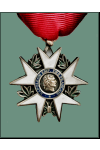Officer of the Legion of Honor
Pronunciation:

Jean-Roch Coignet was born in Druyes-les-Belles-Fontaines, in the province of Nivernais (now the department of Yonne), on August 16, 1776. His father ran an inn and was quite well-to-do. However, faced with the bullying of a stepmother, the eight-year-old boy eventually ran away from home. For a few years, he earned his living by hiring himself out on farms as a laborer. These early years prevented him from acquiring any formal education.
In August 1799, he was drafted into the army as a grenadier.
In his first campaign, Coignet distinguished himself at Montebello, where his conduct earned him a rifle of honor. A few days later, at Marengo, he suffered his first wound, fortunately not a serious one.
After joining the Guard in 1803 and being awarded the Légion d'honneur in July 1804, Coignet took part in all Napoleon I's campaigns.
He was present at Ulm and Austerlitz in 1805, Jena in 1806, Preussisch-Eylau and Friedland in 1807, Somosierra in 1808, Eckmühl, Aspern-Essling and Wagram in 1809, Borodino in 1812, Lützen, Bautzen, Dresden and Hanau in 1813. During the French campaign of 1814, he took part in almost every battle, ending his career at Waterloo in 1815, like Napoleon himself.
Jean-Roch Coignet's service record listed sixteen campaigns and no fewer than forty-eight battles, all without serious injury.
Long hampered by his illiteracy, his career took off when he was appointed corporal in July 1807 − despite this handicap and against the rules − and finally learned to read and write. Coignet was promoted to sergeant in 1809, lieutenant in 1812 and captain in 1813.
Placed on semi-soldier's status after the Second Restoration, watched over by the police like all former officers of the Empire, he settled in Auxerre after refusing to resume service in the royal army. He married in 1818, and lived off a few acres of vines and a small inn. In 1847, he had the satisfaction of finally being allowed to avail himself of the rank of Officer of the Legion of Honor, which he had been awarded during the Hundred Days.
After the death of his wife in August 1848, Coignet began writing the notebooks that would make him famous. He first distributed them to his customers, before publishing them in 1851 under the title Aux vieux de la vieille.
Captain Coignet died on December 10, 1865, and was buried in Auxerre's Saint-Amâtre cemetery.
Jean-Roch Coignet's photograph

Written relying only from memory, the Cahiers du capitaine Coignet are sometimes questionable, but remain a valuable record of the lives of Empire troops and junior officers.
The first complete and faithful edition of the Cahiers was not published until 1968, under the direction of Jean Mistler. Those published up to that point were both faulty and amputated.
In 1969, a television series brought the valiant captain back to life. Henri Lambert played the lead role. It is available on the INA website.
Jean-Roch Coignet was chosen as patron by the 2000-2002 graduating class of the Ecole Militaire Interarmes.